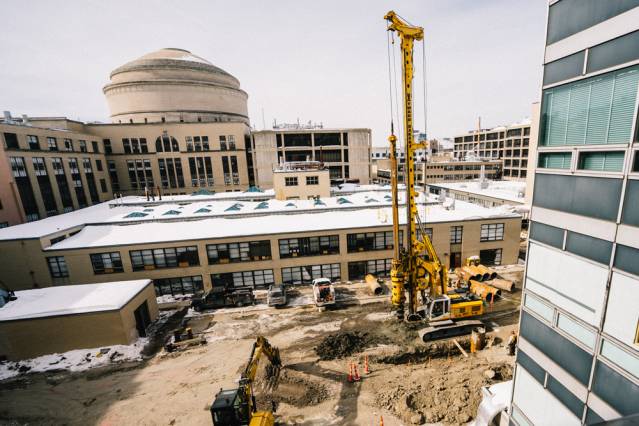MIT.nano is the most ambitious and disruptive construction project in the modern history of MIT. “It won’t be sneaking under anyone’s radar,” says Arne Abramson, MIT’s director of capital projects. So Abramson and his colleagues from MIT Facilities have planned a series of lunchtime talks to give members of the MIT community a window on the details of the construction process. “Because MIT.nano is changing everyone’s patterns drastically in some way or another, we thought it would be a good opportunity to discuss exactly what we’re doing and why we’re doing it,” he says.
 The exterior of Building 12, which will be demolished in the spring to make way for MIT.nano. Photo: Lillie Paquette/School of Engineering
The exterior of Building 12, which will be demolished in the spring to make way for MIT.nano. Photo: Lillie Paquette/School of Engineering
The new facility will replace Building 12 — smack in the center of MIT’s campus. The decision to locate MIT.nano centrally was intended to facilitate access and interaction among researchers, and also to insulate the delicate instruments used in nanoscale imaging and fabrication from vibrations and electromagnetic interference. Those are the up-sides of the location — to be experienced after the building opens, Abramson notes drily. The down-side of MIT.nano’s location, is “an unprecedented degree of disruption” associated with its construction. Staff and researchers in surrounding buildings (which comprise most of the central campus) will spend much of the next four years contending with the noise and dust (and possibly the smells) of construction. Along with everyone else, they will have to manage building closures and detours that will complicate their movement around campus.
The lunchtime series, dubbed the MIT.nano Tool Talks, will have its first installment on March 17 at noon in Room 4-105. The series will be roughly pegged to MIT.nano’s construction timeline, and topics will detail relevant construction techniques that attendees will be able to see out of their windows: from how Building 12 will be demolished, to the fabrication of the slurry wall, to underslab plumbing, to the erection of the site’s central crane, etc. “We figured, why not share what we’re doing with people and start an informal conversation?” says Abramson. “We think the project is really cool, and will interest not only construction geeks but anyone who’s interested in what’s happening on site.”
In the fall, the talk series will expand its focus to include samples of the nanotechnology research that will be done in the facility after its completion in 2018. Topics might include technologies for improving concrete and new kinds of films to coat glass. “People keep saying nanotechnology will be used everywhere, so it will be nice to make the connection to our building,” says Abramson.
In spite of this year’s record-breaking winter weather, the project remains on schedule. Demolition, digging, and earth-moving (1.4 million cubic feet, by one estimate) are scheduled to begin as soon as the snow melts.
Tool Talks Topics
Below is a projected list of the discussion topics for the MIT.nano Tool Talks series. As construction schedules can change, so may the lineup in the series.
March 17, noon, 4-105: Overview of construction sequence and Building 12 demolition prep
- Building preparation
- Selective demo
- Building demo / method
June 2015: Slurry wall – pre-trenching
- Definition, purpose
- Installation process
August 2015: Slurry wall – installation of panels
- General overview of installation process
- Slurry plant
- Installation sequence of panels
October 2015: Excavation (September through December)
- Review of soil pre-characterization
- Removal requirements for classified soil
- Sequence of soil removal and foundation wall bracing
December 2015: Underslab plumbing
- Review of performance requirements
- Installation sequence
February 2016: Crane set-up
- Review of installation logistics and location of crane placement
April 2016: Steel (March through May)
- Review of fabrication / delivery process
- Installation sequence / pick plan
June 2016: Curtain wall (beginning)
- Review of fabrication / delivery process
- Review of performance criteria
October 2016: Curtain wall (completion)
- Review of QA/QC process
- Review of performance testing requirements
Source: http://web.mit.edu/